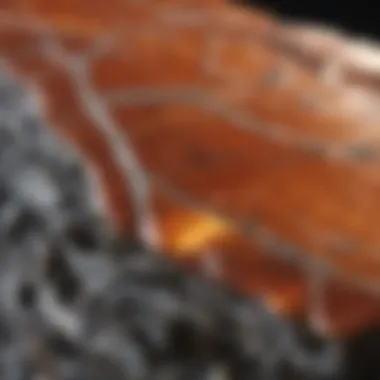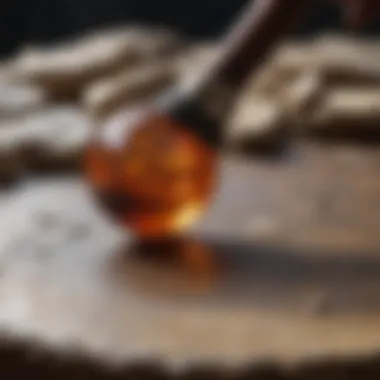Unlocking the Mysteries of Natural Stone Polishing Compounds: A Comprehensive Guide


Rock and Fossil Identification
Natural stone and fossil enthusiasts immerse themselves in a vibrant world where the intrinsic beauty of geological specimens reigns supreme. Within this realm lies the art of natural stone polishing compounds, a captivating fusion of science and craftsmanship aimed at unleashing the hidden allure of rocks and fossils. To embark on this journey, one must first understand the distinctive types of rocks and fossils that serve as raw materials for the polishing process. These geological marvels vary in composition, color, and texture, each bearing a unique story etched in their intricate patterns.
Types of rocks and fossils
Amongst the array of rocks and fossils available for polishing, one encounters a diverse spectrum of options ranging from the timeless elegance of marble to the rugged charm of agate. Each rock type harbors its peculiar characteristics that influence the polishing method and outcome. Granites boast durability and striking patterns, while jaspers flaunt a kaleidoscope of organic colors. Fossils, on the other hand, offer a glimpse into prehistoric worlds with imprints of ancient life forms delicately preserved within their stony embrace.
Characteristics to look for
When selecting rocks and fossils for polishing, collectors keen on achieving exquisite results must pay attention to specific characteristics. Smooth surfaces free from cracks ensure a flawless polishing process, while vibrant colors promise a visually appealing finish. Intricate patterns and unique markings add character to the specimens, elevating their aesthetic appeal. By honing their eye for detail, enthusiasts can discern the most promising rock and fossil candidates for the polishing journey.
Tools for identification
Equipped with a keen understanding of rock and fossil characteristics, collectors arm themselves with an array of tools to aid in identification. Magnifying lenses unveil minute details invisible to the naked eye, allowing for precise examination of textures and patterns. Hardness testing kits assist in distinguishing between different rock types based on their resistance to scratching, aiding in accurate identification. With a meticulous approach to identification, enthusiasts set the stage for a successful venture into the captivating world of natural stone polishing compounds.
Introduction to Natural Stone Polishing Compounds
In the realm of rock and fossil enthusiasts, the realm of natural stone polishing compounds stands as a cornerstone of expertise and craftsmanship. Understanding the properties, applications, and nuances of these compounds is akin to unlocking the hidden potential within geological specimens. As we embark on this journey of discovery, we peer into the intricate world of polishing compounds, where science meets art in a harmonious blend. Through this comprehensive guide, we delve into the depths of polishing techniques, unveiling the secrets that lie beneath the surface of seemingly ordinary stones. With meticulous attention to detail and a keen eye for excellence, we explore the transformative power that these compounds hold, promising to elevate your collection to a whole new level of brilliance and sophistication.
Understanding the Principles of Polishing
Abrasion and Polishing
At the core of the polishing process lies the indispensable concept of abrasion. The meticulous art of abrasion and polishing involves delicately sanding away imperfections, unveiling the true beauty that resides within each stone. This method relies on the consistent friction between the polishing compound and the stone, gradually smoothing its surface to reveal a lustrous sheen. The key characteristic of abrasion and polishing is its ability to enhance both the aesthetic appeal and tactile quality of the stone, making it a preferred choice for enthusiasts seeking exceptional results. While abrasion can achieve impeccable shine, it requires patience and precision to avoid over-polishing that may diminish the stone's natural charm.
Chemical Reactions in Polishing
Another fascinating aspect of stone polishing is the utilization of chemical reactions to amplify the polishing process. By harnessing the power of specialized compounds, these reactions catalyze the transformation of rough surfaces into showcases of elegance. Chemical reactions in polishing offer a unique advantage by providing efficient polishing results even on hard-to-polish stones, ensuring a consistent and impressive finish. However, one must exercise caution due to the reactive nature of certain compounds, which may necessitate stringent safety measures during application.
Types of Polishing Compounds
Within the vast landscape of polishing compounds, a diversity of options awaits the discerning enthusiast. From oxide compounds like iron, cerium, and aluminum oxides to diamond powders and organic compounds like rouge and corn cob grit, the variety is as extensive as it is fascinating. Each type boasts distinct characteristics that cater to different polishing needs, whether it be achieving a mirror-like shine or preserving the stone's natural textures. The choice of polishing compound plays a pivotal role in the polishing process, directly influencing the final outcome of the stone's appearance and durability.
The Role of Polishing Compounds
Enhancing Luster and Shine
Enhancing the luster and shine of polished stones is a primary objective that drives the use of polishing compounds. By selecting the appropriate compound and employing expert techniques, enthusiasts can elevate the visual appeal of their stones to dazzling heights. The key characteristic of enhancing luster and shine is its ability to accentuate the inherent beauty of each stone, unveiling a brilliance that captivates the observer. While this process enhances the aesthetic value of the stone, careful consideration must be given to preserving its authenticity and avoiding excessive alteration.
Smoothing Surface Imperfections
Polishing compounds play a vital role in smoothing out surface imperfections that may detract from the overall appeal of the stone. Whether it is uneven textures, scratches, or blemishes, the right compound can work wonders in restoring the stone's pristine appearance. The key characteristic of smoothing surface imperfections lies in its ability to rejuvenate the stone, providing a flawless canvas for light to dance and reflect. This transformative process requires attention to detail and a steady hand to ensure a seamless finish that highlights the stone's natural beauty.
Preserving Natural Features


While the goal of polishing is often to achieve a flawless finish, preserving the natural features of the stone remains an equally important consideration. Polishing compounds offer a delicate balance between enhancing the stone's appearance and safeguarding its unique characteristics. The key characteristic of preserving natural features is its ability to retain the stone's original allure, showcasing its organic patterns and textures. By choosing the right compound and employing gentle polishing techniques, enthusiasts can honor the innate beauty of the stone while accentuating its captivating qualities.
Types of Natural Stone Polishing Compounds
In the realm of natural stone polishing, understanding the different types of polishing compounds is paramount to achieving remarkable results. These compounds play a vital role in enhancing the beauty and luster of geological specimens, catering to a diverse range of stone compositions and textures. By exploring various types of polishing compounds, individuals can choose the most suitable option based on the specific needs of their stones. Each type offers unique benefits and considerations that contribute to the overall efficacy of the polishing process.
Oxide Polishing Compounds
Oxide polishing compounds are a category of stone polishing agents known for their effectiveness in achieving impeccable finishes. Within this category, specific compounds such as Iron Oxide Compounds, Cerium Oxide, and Aluminum Oxide Polishes stand out for their distinct properties and applications.
Iron Oxide Compounds
Iron Oxide Compounds are characterized by their exceptional abrasive qualities, making them ideal for smoothing and refining stone surfaces. Their magnetic properties enable them to interact with the natural elements of the stone, resulting in a polished finish that showcases the stone's inherent beauty. Despite their abrasive nature, Iron Oxide Compounds are favored for their ability to deliver consistent and high-quality results.
Cerium Oxide
Cerium Oxide is renowned for its versatility and gentle yet effective polishing action. This compound is particularly renowned for its ability to remove fine scratches and imperfections from stone surfaces, restoring them to a pristine condition. Its unique chemical composition enables it to interact harmoniously with a wide range of stone types, making it a popular choice among polishing enthusiasts seeking optimal results.
Aluminum Oxide Polishes
Aluminum Oxide Polishes are celebrated for their durability and efficiency in polishing various types of stones. With their firm abrasive properties, these polishes excel in treating hard stones and achieving smooth, glossy finishes. The precision and control offered by Aluminum Oxide Polishes make them a preferred option for individuals looking to polish stones with intricate details and diverse textures.
Diamond Polishing Compounds
Diamond polishing compounds represent the pinnacle of stone polishing technology, thanks to the exceptional hardness and efficacy of diamonds in refining stone surfaces. Industrial Diamond Powders and Diamond Suspension are two prominent subtypes within this category, each offering unique benefits and applications.
Industrial Diamond Powders
Industrial Diamond Powders are coveted for their unparalleled cutting and polishing abilities, capable of transforming rough stone surfaces into dazzling masterpieces. Their abrasive strength and precision make them indispensable for shaping and enhancing stones with utmost accuracy and finesse. Despite their high cost, the exceptional results delivered by Industrial Diamond Powders justify their prominence in the world of stone polishing.
Diamond Suspension
Diamond Suspension, a liquid-based variant of diamond polishing compounds, offers a versatile solution for achieving superior gloss and clarity on stone surfaces. Its fluid nature allows for seamless application and even distribution, ensuring uniform polishing results across the entire stone. By harnessing the abrasive power of diamonds in suspension form, enthusiasts can elevate the visual appeal of their stones with ease and precision.
Organic Polishing Compounds
Organic polishing compounds provide a natural and eco-friendly alternative for stone polishing, catering to individuals seeking a sustainable approach to enhancing their geological specimens. A closer look at Rouge Compounds and Corn Cob Grit sheds light on the distinct characteristics and benefits of these organic options.
Rouge Compounds
Rouge Compounds, derived from natural mineral sources, offer a gentle yet effective way to buff and polish stones to a stunning sheen. Their non-toxic nature and gentle abrasiveness make them suitable for delicate stones that require a careful touch during the polishing process. Rouge Compounds are ideal for imparting a smooth, mirror-like finish to stones without compromising their natural aesthetics.
Corn Cob Grit
Corn Cob Grit presents a sustainable and biodegradable option for those looking to polish stones without synthetic additives. This compound's organic composition allows for gentle exfoliation of stone surfaces, gradually revealing their innate beauty without harsh abrasives. Corn Cob Grit excels in delicately enhancing the textures and colors of stones, providing a natural and eco-conscious approach to stone polishing.


Choosing the Right Polishing Compound
In the intricate process of natural stone polishing, selecting the appropriate polishing compound is paramount. The significance of this topic lies in its pivotal role in determining the final outcome of the stone's appearance. By carefully choosing the right polishing compound, one can achieve a flawless finish, enhance the natural characteristics of the stone, and ensure longevity.
Factors to Consider
Hardness of Stone
The hardness of the stone is a critical factor to contemplate when deciding on the polishing compound. Stones vary in their hardness levels, with some being softer and more delicate, while others are harder and robust. Understanding the hardness of the stone enables the proper selection of a polishing compound that complements it. Opting for a polishing compound that is compatible with the stone's hardness helps in achieving a smooth and even polish, bringing out the innate beauty of the natural material.
Desired Finish
The desired finish plays a crucial role in the choice of polishing compound. Whether aiming for a glossy sheen, a matte look, or a specific texture, the desired finish guides the selection process. Different polishing compounds yield varying finishes, from high gloss to satin-like textures. By aligning the desired finish with the appropriate polishing compound, one can achieve the exact aesthetic appeal envisioned for the stone surface.
Application Method
Another vital aspect to consider is the application method of the polishing compound. The method of application influences the distribution of the compound, the level of abrasiveness, and the overall efficiency of the polishing process. From hand application techniques to mechanical polishing methods, each approach offers distinct advantages and challenges. Selecting the right application method ensures uniform coverage, optimal abrasion, and a seamless polishing experience.
Compatibility and Suitability
Matching Compound to Stone Type
Matching the polishing compound to the stone type is imperative for a successful polishing endeavor. Different stones react differently to various compounds, with some requiring specific formulations for optimal results. By matching the compound to the stone type based on their properties and composition, one can maximize the polishing efficiency and protect the integrity of the stone surface.
Avoiding Damage or Discoloration
Mitigating the risk of damage or discoloration is a key consideration when selecting a polishing compound. Certain compounds may interact adversely with specific stone types, leading to color alteration or surface harm. By being mindful of potential risks and choosing compounds that safeguard against damage, one can ensure a safe and effective polishing process without compromising the stone's quality.
Environmental Considerations
Environmental considerations are increasingly important in modern polishing practices. Selecting eco-friendly and sustainable polishing compounds aligns with green principles and minimizes the ecological impact of the process. By choosing environmentally responsible compounds, enthusiasts can promote conservation efforts and contribute to a greener approach to stone polishing, supporting both quality results and environmental welfare.
Application Techniques for Polishing Compounds
In this section of the article, we delve into the crucial aspect of applying polishing compounds to natural stones. Understanding the application techniques is key to achieving a flawless finish on geological specimens. The meticulous application of polishing compounds enhances the beauty of the stones and brings out their natural characteristics. To master the art of polishing, one must grasp the intricacies of various application methods and tools available.
Hand Polishing
Applying Compound by Hand
When it comes to applying polishing compounds by hand, the meticulous nature of this technique allows for controlled and precise polishing. The hands-on approach enables the user to feel the stone's texture and adjust the pressure accordingly. This tactile feedback is invaluable in achieving a smooth and uniform finish on the stone surface. Despite requiring more time and effort than mechanical methods, hand polishing offers unmatched attention to detail and customization.
Rubbing and Buffing Techniques
The rubbing and buffing techniques employed during hand polishing play a significant role in the final outcome of the stone's appearance. By gently rubbing the compound in circular motions and buffing it to a shine, the stone gradually reveals its luster. These techniques require patience and skill to ensure an even polish across the entire surface of the stone. While time-consuming, the precision and finesse achieved through rubbing and buffing are worth the meticulous effort.


Polishing Cloth Selection
Choosing the right polishing cloth is imperative for successful hand polishing. The fabric of the cloth, its absorbency, and the texture all impact the polishing process. A soft and non-abrasive cloth is preferred to prevent scratches on the stone surface. The cloth should also be resistant to fraying to maintain a consistent polish. Selecting the appropriate polishing cloth is a critical step in achieving a professional finish on natural stones.
Mechanical Polishing
Using Rotary Tools
Utilizing rotary tools for polishing offers efficiency and speed in treating larger stone surfaces. The rotary motion of the tools ensures uniformity in the application of polishing compounds, covering more area in less time. This method is ideal for working on larger projects where hand polishing may be impractical. However, care must be taken to control the pressure and speed of the rotary tools to prevent damage to the stone.
Effective Polishing Machines
Effective polishing machines are essential for enhancing productivity and achieving consistent results in stone polishing. These machines come in various designs tailored to specific polishing needs. From small handheld polishers to large industrial machines, choosing the right equipment is paramount for successful stone polishing. Modern polishing machines offer advanced features such as variable speed control and adjustable pressure settings, allowing for precision in the polishing process.
Safety Precautions
Prioritizing safety precautions is paramount when engaging in stone polishing using mechanical methods. Protective gear such as goggles, gloves, and masks must be worn to prevent injuries from flying debris and chemical exposure. Additionally, proper ventilation in the workspace is crucial to avoid inhalation of polishing dust. Following safety protocols and equipment guidelines ensures a secure and controlled working environment during mechanical polishing procedures.
Maintenance and Care of Polished Stones
In the realm of natural stone polishing, the maintenance and care of polished stones play a vital role in upholding their pristine appearance and ensuring longevity. By adhering to proper maintenance practices, enthusiasts can safeguard their polished stones from wear and tear, preserving their inherent beauty for generations to come. Attention to detail in maintenance is paramount, as it not only sustains the aesthetic appeal of polished stones but also maintains their structural integrity. The considerations for maintenance and care extend beyond surface-level cleanliness, encompassing strategies to protect the stones from environmental factors that could dull their luster or cause damage.
Cleaning and Preservation
Proper Storage Practices
Proper storage practices are fundamental to the maintenance of polished stones, offering a sheltered environment that shields them from potential harm. This involves storing stones in dry and stable conditions to prevent moisture damage or discoloration. Implementing proper storage practices ensures that the stones retain their natural shine and integrity, free from the influence of adverse external elements. By utilizing suitable storage solutions, such as protective cases or humidity-controlled displays, collectors can prolong the life and allure of their polished stones.
Regular Cleaning Regimens
Regular cleaning regimens are essential for removing dust, dirt, and debris that accumulate on polished stones over time. Consistent cleaning not only maintains the visual appeal of the stones but also prevents abrasive particles from scratching their surfaces. By adopting a gentle cleaning approach with specialized tools and solutions, collectors can effectively rid their stones of impurities without causing any damage. Establishing a routine for regular cleaning ensures that the stones remain radiant and unblemished, showcasing their natural characteristics with brilliance.
Avoiding Common Pitfalls
In the pursuit of maintaining polished stones, it is crucial to be aware of common pitfalls that could undermine their beauty and structural integrity. Avoiding exposure to harsh chemicals, extreme temperatures, or direct sunlight can safeguard the stones from potential deterioration. Additionally, exercising caution during handling and storage can prevent accidental damage or breakage. By identifying and circumventing these common pitfalls, collectors can safeguard their treasured stones for prolonged enjoyment and admiration.
Enhancing Longevity
The longevity of polished stones can be significantly enhanced through strategic measures that fortify their durability and visual appeal. By implementing protective coatings, preventive measures, and utilizing repolishing techniques, collectors can ensure that their stones endure the test of time, retaining their allure for years to come.
Protective Coatings
Applying protective coatings to polished stones forms a shield against external aggressors, such as scratches and stains, thereby extending the stones' lifespan. These coatings act as a barrier that safeguards the stones' surfaces from wear and maintains their glossy finish. Choosing high-quality protective coatings tailored to the type of stone enhances their resilience and imparts a lasting gleam, enhancing the stones' overall aesthetic appeal.
Preventive Measures
Integrating preventive measures into the care routine of polished stones serves as a proactive approach to maintaining their quality and safeguarding against potential harm. By monitoring environmental conditions, avoiding contact with corrosive substances, and incorporating safe handling practices, collectors can prevent avoidable damage and degradation. Implementation of preventive measures reinforces the longevity of polished stones, ensuring that they remain flawless and captivating over time.
Repolishing Techniques
Repolishing techniques offer a rejuvenating solution for polished stones exhibiting signs of wear or dullness, reviving their shine and vibrancy. With the use of specialized polishing compounds and meticulous polishing practices, collectors can restore the stones to their former glory. Identifying the appropriate repolishing techniques based on the stone's composition and condition is essential for achieving optimal results without compromising their integrity. By mastering repolishing techniques, enthusiasts can reaffirm the splendor of their polished stones, perpetuating their beauty for continued admiration and appreciation.







